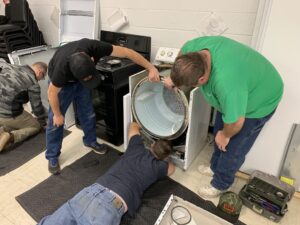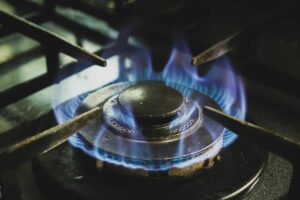Understanding refrigerator troubleshooting is essential for every homeowner. A refrigerator is a vital appliance in any household, and when it malfunctions, it can cause inconvenience and potentially lead to food spoilage. By learning how to troubleshoot common refrigerator problems, you can save time and money by fixing the issue yourself instead of calling a professional repair service. In this article, we will explore the basics of refrigerator troubleshooting, common problems, and how to fix them.
Key Takeaways
- Understanding the basics of refrigerator troubleshooting can save you time and money.
- Common refrigerator problems include temperature issues, leaks, and strange noises.
- Checking the power source is the first step in troubleshooting a refrigerator problem.
- Inspecting the thermostat can help identify temperature issues.
- Cleaning the condenser coils and checking the door seals can improve refrigerator efficiency.
Understanding the Basics of Refrigerator Troubleshooting
To effectively troubleshoot a refrigerator, it is important to understand how it works and the components involved. Refrigerators work by removing heat from the interior and transferring it to the surrounding environment. This process is achieved through a combination of components such as compressors, condenser coils, evaporator coils, fans, and thermostats.
Common troubleshooting tools include a multimeter for testing electrical connections, a flashlight for inspecting components, and a vacuum cleaner for cleaning condenser coils.
Identifying Common Refrigerator Problems
There are several common problems that can occur with refrigerators. These include the refrigerator not cooling properly, the freezer not freezing, strange noises coming from the appliance, leaks, and issues with the ice maker.
When the refrigerator is not cooling properly, it could be due to a faulty compressor or condenser fan motor. The freezer not freezing could be caused by a malfunctioning defrost timer or thermostat. Strange noises can indicate problems with the evaporator fan motor or the condenser fan motor. Leaks can be caused by a clogged defrost drain or a faulty water inlet valve. Ice maker issues can be caused by a malfunctioning ice maker module or a clogged water line.
Checking the Power Source
Before diving into troubleshooting specific components, it is important to check the power source of the refrigerator. Start by inspecting the power cord for any signs of damage or fraying. If the power cord appears to be in good condition, test the outlet by plugging in another appliance to see if it works. If the outlet is functioning properly, check the circuit breaker to ensure it has not tripped.
Inspecting the Thermostat
The thermostat controls the temperature inside the refrigerator. If the refrigerator is not cooling properly, it is important to check the thermostat settings. Make sure the thermostat is set to the desired temperature and that it is not accidentally turned off or set to a very low temperature.
To test the thermostat, use a multimeter to measure its continuity. If there is no continuity, it means that the thermostat is faulty and needs to be replaced.
Cleaning the Condenser Coils
Clean condenser coils are essential for proper refrigerator functioning. Over time, dust and debris can accumulate on the coils, reducing their efficiency and causing the refrigerator to work harder to cool down. This can lead to higher energy consumption and potential breakdowns.
To clean the condenser coils, first, unplug the refrigerator and locate the coils. They are usually located at the back of the appliance or underneath it. Use a vacuum cleaner with a brush attachment to gently remove any dust or debris from the coils. Be careful not to damage the coils while cleaning.
Checking the Door Seals
Tight door seals are crucial for maintaining proper temperature levels inside the refrigerator. If the door seals are loose or damaged, cold air can escape, leading to inefficient cooling and potential food spoilage.
To check the door seals, close the refrigerator door on a piece of paper or dollar bill. If you can easily pull out the paper or bill without resistance, it indicates that the door seals are not tight enough and need to be replaced. You can purchase replacement door seals from appliance stores or contact a professional repair service for assistance.
Troubleshooting Refrigerator Leaks
Refrigerator leaks can be caused by various factors. Common causes include a clogged defrost drain, a faulty water inlet valve, or a cracked water line. To fix a clogged defrost drain, use a turkey baster or a pipe cleaner to remove any debris blocking the drain. If the water inlet valve is faulty, it will need to be replaced. A cracked water line can be repaired by replacing the damaged section.
Fixing Ice Maker Issues
Ice maker issues can be frustrating, especially during hot summer months. Common problems include the ice maker not producing ice, producing small or misshapen ice cubes, or not dispensing ice properly.
To troubleshoot ice maker issues, start by checking the water supply line for any blockages. Ensure that the water valve is fully open and that the water pressure is sufficient. If the ice maker is not producing ice at all, it may be necessary to replace the ice maker module.
Addressing Strange Noises
Strange noises coming from the refrigerator can be a cause for concern. Common causes include a faulty evaporator fan motor, a worn-out condenser fan motor, or a malfunctioning compressor.
To fix strange noises, first, locate the source of the noise by listening carefully and inspecting the components. If it is determined that a fan motor is causing the noise, it will need to be replaced. If the compressor is making unusual sounds, it may be necessary to call a professional repair service as compressor repairs can be complex.
When to Call a Professional Refrigerator Repair Service
While many refrigerator problems can be fixed through DIY troubleshooting, there are instances where it is best to call a professional repair service. Signs that you may need professional help include electrical issues such as tripping circuit breakers or sparking outlets, major component failures such as a faulty compressor or condenser fan motor, and refrigerant leaks.
Hiring a professional repair service has several benefits. They have the expertise and experience to diagnose and fix complex issues, they have access to specialized tools and replacement parts, and they can provide warranties on their work.
Understanding refrigerator troubleshooting is essential for every homeowner. By learning how refrigerators work, identifying common problems, and following the appropriate troubleshooting steps, you can save time and money by fixing the issue yourself. Regular maintenance, such as cleaning condenser coils and checking door seals, can also help prevent future problems. However, in cases of major component failures or electrical issues, it is best to call a professional repair service to ensure the safety and longevity of your refrigerator.
Can the Troubleshooting Tips for Refrigerators also Apply to Specific Problems in the Step-by-Step Guide?
Yes, troubleshooting refrigerator problems can also apply to specific issues in the step-by-step guide. Most troubleshooting tips for refrigerators, such as checking the power supply, cleaning the condenser coils, and inspecting the door seals, can be relevant to solving various specific problems outlined in the guide.
FAQs
What are some common problems with refrigerators?
Some common problems with refrigerators include not cooling properly, making strange noises, leaking water, and having a faulty ice maker.
What should I do if my refrigerator is not cooling properly?
If your refrigerator is not cooling properly, check the temperature settings, clean the condenser coils, and make sure the door seals are tight. If these troubleshooting tips do not work, it may be time to call a professional repair service.
Why is my refrigerator making strange noises?
Refrigerators can make strange noises due to a variety of reasons, including a faulty compressor, a clogged condenser fan, or a malfunctioning evaporator fan. It is best to have a professional diagnose and repair the issue.
How do I fix a leaking refrigerator?
To fix a leaking refrigerator, check the drain pan and drain line for clogs or damage. If these are clear, check the door seals for any gaps or damage. If the issue persists, it may be a problem with the defrost drain or water inlet valve, which should be repaired by a professional.
What should I do if my ice maker is not working?
If your ice maker is not working, check the water supply line for any clogs or damage. Also, make sure the ice maker is turned on and the freezer temperature is set correctly. If these troubleshooting tips do not work, it may be time to call a professional repair service.



